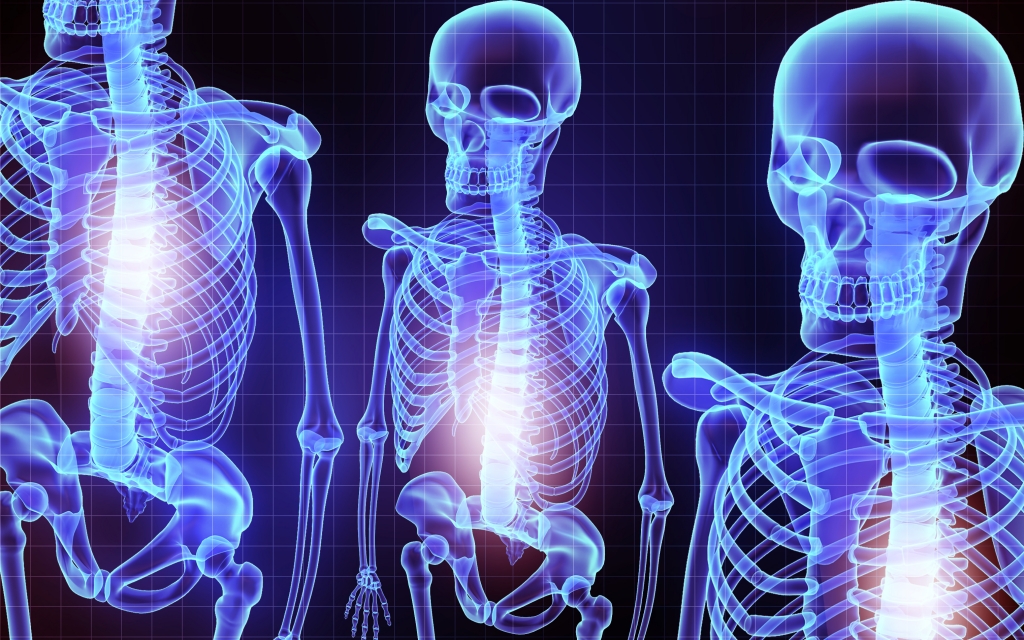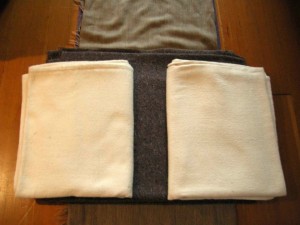
See where the collarbones meet the sternum? That's it for the shoulder girdle's connection to the ribcage.
The thing about the shoulder exercises gathered on this page is that they all work, in the sense that a good cookbook works if you actually open it and cook.
But just as cooking has principles that extend through every recipe, yoga has certain principles of movement that work in almost most every pose. Correct shoulder action in one pose is correct shoulder action for almost all poses. (Lolasana and related poses are one exception that springs to mind.)
So you might consider these Five-Minute Yoga Challenges as recipes:
Use a Long Strap to Put Your Shoulders in Their Place
Clasp Your Hands to Open Your Shoulders
Ease Your Shoulders in Gomukhasana
Make Right Angles to Strengthen Your Shoulders
Stand Tall By Working Your Shoulder Blade Stabilizers
Extend, Don’t Grip in Headstand
Reverse the Curve: Chest Opening Over a Blanket
Supported Bridge Pose: Cross Over into Quiet
Viparita Dandasana: Back Bend Over a Chair
And these are the general guidelines to help you cook with your shoulders.
• Look closely at a skeleton. Notice that the shoulders and arms make a delicate “girdle” that drapes over the upper rib cage – a girdle so expressly designed for mobility that it’s attached to the ribcage, bone-to-bone, in only one place: where the collarbones meet the sternum.
Incorporate that image into your mental body map, and remember, despite what it sometimes feels like, your shoulder blades are not nailed in place. It’s in their nature to glide.
• Whenever you can, roll your upper arm bones out – your palms will rotate forward. Notice how doing that firms your shoulder blades and presses their outer edges gently toward your spine.
Then bend your elbows, pull the backs of your elbows gently down, and draw your inner shoulder blades down your back.
This outward rotation of the upper arms, and downward action of the inner shoulder blades is present in almost every yoga pose. Make it part of your body’s habit pattern, and it will be that much more accessible when you practice.
• In shoulder stand, make sure that you can press down on your outer shoulders.
If you can’t, and instead you feel weight on your neck, try this shoulder stand setup from Donald Moyer.
Even if you’re just not sure, give it a try. If you suddenly find a new clarity and strength in your shoulders, you’ll be glad you did.
This setup, by the way, isn’t necessarily your new shoulder stand prop forever.
The goal is to work the outer shoulders so well, and become so strong and open, that you can work on a flat surface.
But you won’t move toward that goal if you can’t work your outer shoulders in the first place.
That would be like trying to bake without turning on the oven.
If you like this post, you might also like:
Build Your Inner Strength in Half Arm Balance





Comments on this entry are closed.
Hi Eve,
I’ve just been going through the great shoulder openers. I have a thing about the fingers in headstand. I do feel the difference with straight fingers. Yet, I find with one baby finger on the outside it puts so much pressure on the finger my baby finger hurts even though I’m pressing my wrists down!– Maybe I am doing something wrong? I have always sort of tucked one baby finger inside the other and then my 2 hand sides and wrists are even on the floor and my balance feels more stable. I don’t know what is thought of this, if it is wrong or not? If you care to explore this– thanks
Hey Elizabeth,
I’ve always been told that tucking the baby finger inside is not a good idea, although I can’t pretend to tell you exactly why. I do know what you’re talking about with the wrists feeling more even and less strain in the fingers when you tuck it in.
For me it’s less the baby fingers than the ring fingers. Every time I do a headstand I have to take my wedding ring off, or the pain in my fingers will take me out of the pose.
Intuition says that for both of us, the solution is in working the hands less and the forearms more. Even when I’m stretching my fingers away from my hands, I’m still trying to keep my hands relaxed. Over time it’s been getting better. My fingers used to get wet with sweat and go white in headstand – quite disturbing really.
I hope that helps.